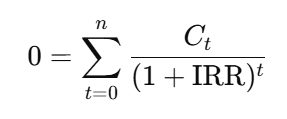IRR (Internal Rate of Return)
The Internal Rate of Return (IRR) is a vital metric in finance and investment. By understanding how to calculate IRR and its implications for financial decision-making, investors can make more informed choices.
What is IRR (Internal Rate of Return) and Why Does It Matter?
When it comes to investment decisions, Internal Rate of Return (IRR) is one of the most powerful financial metrics to understand. This value is essential for investors because it helps measure the potential profitability of an investment over time. In other words, IRR tells you the annualized rate of return, making it crucial for comparing different projects and ensuring you’re making smart financial moves.
Key Benefits of IRR for Investors
IRR stands out as a preferred metric for investors due to its ability to:
- Compare multiple investment opportunities.
- Provide a clear understanding of expected returns.
- Aid in informed decision-making, especially for long-term projects.
This measure gives insight into whether a project’s profitability surpasses its costs, helping investors decide if an opportunity meets their financial targets.
How to Calculate IRR (Internal Rate of Return)
Calculating IRR may seem complex, but it’s based on understanding cash flows over time. IRR is the rate at which the Net Present Value (NPV) of cash inflows equals the NPV of cash outflows. Here’s a quick look at the formula:
Formula for IRR Calculation:


Where:
- = Cash flow at time t
- = Total number of time periods
Why is IRR Important?
Understanding and calculating IRR is crucial for several reasons:
- Investment Evaluation: IRR helps in evaluating the potential returns on investments.
- Comparative Analysis: It allows investors to compare different projects or investments.
- Decision Making: A higher IRR indicates a more attractive investment opportunity.
How to Calculate IRR
Calculating IRR involves finding the rate that makes the NPV of cash flows zero. Here’s a step-by-step guide:
Step 1: Identify Cash Flows
List all cash flows associated with the investment. This includes initial investment (typically a negative cash flow) and all subsequent cash inflows or outflows over the investment period.
Step 2: Set Up the NPV Equation
Set up the NPV equation using the cash flows identified:
Where:
- C0 is the initial investment (usually negative)
- C1,C2,…,Cn are the cash inflows for each period.
Step 3: Solve for IRR
To find the IRR, set the NPV equation to zero and solve for rr:
This equation cannot be solved algebraically, so numerical methods or financial calculators are typically used.
Example of IRR Calculation
Let’s consider an example:
- Initial Investment (C₀): -$10,000
- Year 1 Cash Flow (C₁): $4,000
- Year 2 Cash Flow (C₂): $4,500
- Year 3 Cash Flow (C₃): $5,000
Setting up the equation:
You would then use a financial calculator or software (like Excel) to find the IRR.
Practical Example of IRR Calculation
Let’s say you’re considering an investment of $10,000 that promises annual returns of $3,000 for the next 5 years. Here’s how IRR would work in this context:
- The IRR function in Excel would compute this as an IRR of approximately 16.4%.
- This means your investment would grow annually at an effective rate of 16.4%, providing a clear way to compare this opportunity to other investment options.
Why IRR is Essential for Long-term Projects
In investment analysis, IRR is crucial for evaluating the profitability of long-term projects. It helps investors:
- Gauge the project’s return compared to its cost.
- Make better financial planning decisions based on potential returns.
For projects with upfront costs and delayed returns, the IRR offers a reliable assessment of long-term profitability.
Pros and Cons of Using IRR in Investment Analysis
While IRR is valuable, it’s essential to recognize both its benefits and limitations.
Pros:
- Provides a clear metric to assess the annualized return.
- Useful for ranking multiple investments with different time frames.
- Can guide better decision-making for capital allocation.
Cons:
- Assumes that cash flows are reinvested at the IRR, which may not always be realistic.
- Doesn’t account for the scale of an investment, which can lead to misleading conclusions.
For these reasons, using IRR alongside other metrics, like Net Present Value (NPV), can offer a more comprehensive view.
IRR vs. Other Financial Metrics: What Makes It Unique?
Investors often compare IRR with other metrics, such as Return on Investment (ROI) and Net Present Value (NPV), to make the best financial decisions. Here’s how IRR stacks up against these metrics:
- IRR vs. ROI: While ROI shows total growth percentage, IRR gives the rate at which an investment grows annually, providing a time-adjusted view.
- IRR vs. NPV: NPV presents the dollar value of returns over time, while IRR focuses on the growth rate, helping to assess relative profitability.
Real-world Application of IRR in Business Decisions
Consider a company deciding whether to launch a new product. By calculating the IRR, the company can assess if the product’s future returns justify the initial investment. If the IRR surpasses the company’s required return, the project is financially viable. Similarly, IRR helps in choosing between potential projects, ranking them based on expected returns.
Common Pitfalls in Relying Solely on IRR
Although IRR is insightful, it has limitations that investors should consider:
- Assumption of Reinvestment: IRR assumes reinvestment of interim cash flows at the IRR rate, which may not always be achievable.
- Single Metric Limitation: Using IRR alone may overlook the project’s size or actual dollar returns, leading to potentially suboptimal decisions.
Therefore, combining IRR with NPV or Payback Period analysis can ensure a more well-rounded view of an investment’s viability.
Key Takeaways: Is IRR Right for Your Investment Strategy?
Understanding and using Internal Rate of Return can significantly impact your investment strategy. By calculating and comparing IRR values for different projects, you can make smarter decisions about where to allocate capital. However, remember that IRR is most useful when used alongside other financial metrics to get a well-rounded view of potential returns.








